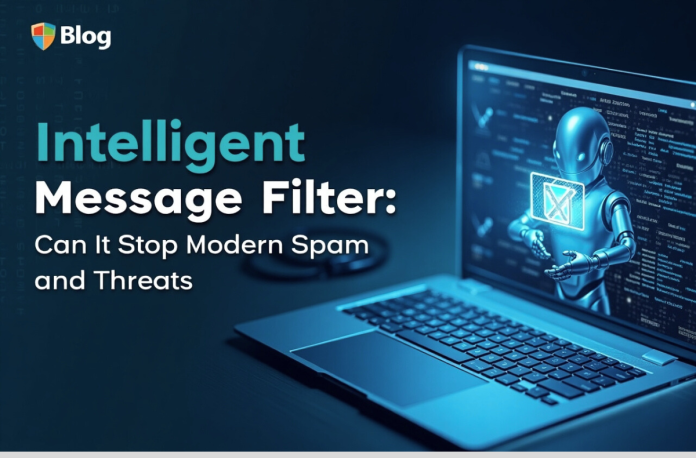Professional communication heavily relies on email, but it is also the most common target for spam, phishing, and malicious attachments. An Intelligent Message Filter can help mitigate these cyber threats. More than 45% of global emails are classified as spam, according to recent cybersecurity reports. Almost half of the messages you receive are irrelevant or dangerous, and without a proper filtering system, your inbox may soon become a dumping ground for them.
Intelligent Message Filter works as a digital gatekeeper that analyzes, learns, and blocks spam before it ever reaches you. The objective is to prevent unwanted and harmful content from reaching users and keep important emails available regardless of whether you are running Exchange Intelligent Message Filter or depend on Microsoft Intelligent Message Filter in your setup.
Key Takeaways
- The Intelligent Message Filter (IMF) blocks spam and phishing emails before they reach your inbox, acting as a crucial digital gatekeeper.
- IMF assigns a Spam Confidence Level (SCL) to each email and filters them based on content analysis and pattern recognition.
- In 2025, the IMF remains effective due to its customizability, low overhead, and compatibility with various Exchange Server environments.
- Using IMF enhances server resource efficiency by preventing spam-related clutter and reducing unnecessary processing loads.
- For optimal results, regularly update filtering rules and educate users about potential threats, as IMF complements other security measures.
Table of Contents
- What is the Intelligent Message Filter?
- Why the Intelligent Message Filter is Still Efficient in 2025
- How the Intelligent Message Filter Works
- Key Features of the Intelligent Message Filter
- Advantages of Using the Intelligent Message Filter
- IMF Vs. Next-Generation Cloud Filtering
- Tips for Getting the Most from Intelligent Message Filter
- Misconceptions Regarding the IMF
- Future of Intelligent Message Filtering
- Conclusion
- FAQs
What is the Intelligent Message Filter?
The Intelligent Message Filter is Microsoft’s email spam-filtering technology, introduced in Exchange 2003. It assigns a score to every email message detected and filters messages accordingly. Over the years, as more complex spam detection methods were added, IMF evolved into more sophisticated versions in Exchange 2010 Intelligent Message Filter and Exchange 2016.
Unlike basic filters that match specific “spam” phrases, the IMF performs significantly better in assessing whether an email is spam. The IMF employs scoring algorithms, pattern recognition, and content analysis.
Most of us have experienced an email mysteriously landing in the “Junk” folder; that is IMF in action.
Why the Intelligent Message Filter is Still Efficient in 2025
Most organizations presume that cloud-based email platforms like Microsoft 365 make stand-alone spam filters obsolete. That’s not correct. Although newer alternatives have been developed, the IMF remains an essential component of layered email security.
Here’s why it is still efficient in 2025:
| Customizability | Administrators can tune filtering messages to suit their organization’s particular requirements. |
| Low Overhead | The Intelligent Message Filter runs in the background without interrupting your workflow. |
| Compatibility | It works well with multiple Exchange Server environments. |
Imagine the IMF as the initial security checkpoint on your organization’s email highway. Yes, you do have other checkpoints (such as antivirus and advanced threat protection), but IMF prevents suspicious vehicles from even entering the road.
How the Intelligent Message Filter Works
The Intelligent Message Filter assigns a Spam Confidence Level (SCL) to every email.
Here’s a step-by-step simplification:
- Email Arrival: The message arrives at your server.
- Content Analysis: IMF reads the subject line, body text, headers, and other metadata.
- Pattern Recognition: It looks for suspicious patterns, such as common spam words or identifiable spammer domains.
- SCL Assignment: It is rated on a scale of 0 (safe) to 9 (most definitely spam).
- Action Based on Score:
| Low score | Email sent to Inbox |
| Medium score | Email sent to Junk folder |
| High score | Email rejected outright |
This would be the case, for instance, with an email that threatens a “limited-time investment opportunity” with several exclamation points and dubious links, and the IMF would give it an SCL 8 or 9, blocking it completely.
How It Improves Email Security & Spam Protection
First-Line Defense Against Threats
Intelligent Message Filter blocks and filters emails at the server, scores them, and prevents the potential arrival of numerous spam and phishing incidents in the user’s inbox, thereby decreasing the risk of social engineering attacks.
Layered Security Approach
The best cybersecurity tips focus on in-depth defense. This first line of defense, which complements other tools such as antivirus software, malware scanning, and cloud-based threat intelligence, is the IMF.
Customizable Protection
The IMF allows administrators to configure thresholds, blocklists, and safelists to best suit the particular requirements of an organization, unlike other cloud filters that are generic and can be applied to all email organizations.
Resource Optimization
Filtering spurious content first, IMF prevents unnecessary server load, saves storage space, and conserves bandwidth used to process irrelevant or malicious emails.
Compliance and Control
Companies with strong regulatory or privacy concerns may find greater on-premises flexibility in configuring email filtering with Intelligent Message Filter, helping them meet compliance needs more independently of cloud-based services.

IMF in Different Exchange Versions
Exchange 2003 Intelligent Message Filter
Exchange 2003’s intelligent message filter was revolutionary when it first came out. Spam filtering was either completely manual or based on third-party software beforehand. The 2003 version of the IMF introduced content-based filtering and SCL scoring, which significantly simplified spam management for IT departments.
Exchange 2010 Intelligent Message Filter
In IMF Exchange 2010, Microsoft improved detection algorithms and performance. It was able to detect intelligent instant message filter scenarios, like spam in the form of legitimate chat notices, more effectively.
Exchange 2016 Intelligent Message Filter
The intelligent message filter in Exchange 2016 further enhanced speed, accuracy, and compatibility with contemporary email authentication protocols such as SPF, DKIM, and DMARC. By integrating with the Exchange Transport pipeline, it was able to handle massive amounts of mail with negligible delays.
Key Features of the Intelligent Message Filter
1. Spam Confidence Level (SCL) Scoring
SCL score is the foundation of Intelligent Message Filter. It provides for fine-grained control over how aggressive the filtering needs to be. For instance, a financial institution may have a lower tolerance for spam than a social mailing list.
2. Customizable Thresholds
Thresholds are customizable by administrators for:
| Junk E-mail Folder threshold | What score jams emails to Junk? |
| Delete threshold | What score deletes emails outright? |
3. Integration with Outlook Junk Email Filter
When the IMF is used with Outlook, spam scoring at both the server and the client level is uniform.
4. Smart Messaging Features
The IMF features smart messaging, including pattern learning, bulk email detection, and adaptive filtering, which makes it smarter over time.
Advantages of Using the Intelligent Message Filter
- Less Inbox Clutter: If the IMF is configured correctly, spam traffic in user mailboxes can decline by 80–95%. That’s fewer minutes spent deleting trash and more minutes spent on real work.
- Improved Defense Against Phishing: Phishing messages often contain subtle clues, such as a domain mismatch, an unusual link structure, or suspicious wording. IMF’s content analysis detects many of them before they can cause trouble.
- Server Resource Efficiency: By filtering spam before it reaches the mailbox store, IMF reduces storage bloat and improves server performance.
IMF Vs. Next-Generation Cloud Filtering
Some IT admins ask themselves: “If I’m using Microsoft Defender for Office 365, do I still need IMF?”
Here’s the reality:
- Cloud filters are effective at catching high-volume, worldwide potential spam campaigns in real-time.
- The Intelligent Message Filter provides local, customizable control and is great for hybrid or on-premises environments.
The two are not mutually exclusive in reality, and most organizations stack them for complete protection.
Tips for Getting the Most from Intelligent Message Filter
- Fine-Tune SCL Thresholds: Don’t be afraid to deviate from defaults. Track your spam and false-positive rates for several weeks, then fine-tune thresholds as necessary.
- Whitelist Trusted Senders: Prevent blocking essential emails by adding trusted domains or addresses to your safe sender list.
- Regularly Update Filtering Rules: Spammers are constantly evolving. Although the IMF’s algorithms are robust, keeping your Exchange and filtering definitions up to date provides improved accuracy.
- Educate Users: Even the most effective filter is not infallible; train staff to alert on suspicious e-mail and report false negatives.
Misconceptions Regarding the IMF
“It’s outdated.”
Although initially released in 2003, Intelligent Message Filter has undergone significant improvements in subsequent versions to remain relevant to today’s threats.
“It blocks too much legitimate email.”
False positives are possible with any filter; however, IMF’s safe sender lists and adjustable thresholds make it a very user-configurable option.
“It’s the only spam filter I need.”
The IMF is effective, but it is best used as part of a layered security approach that includes antivirus, anti-malware, and cloud security.
Future of Intelligent Message Filtering
While Microsoft’s emphasis has turned to cloud-based offerings, IMF remains relevant to:
- On-premises Exchange implementations
- Hybrid scenarios
- Specialized compliance configurations
Future versions may incorporate machine learning into IMF itself to further enhance real-time responsiveness to emerging spam patterns.
Conclusion
The Intelligent Message Filter remains a dependable, customizable, and effective way to block spam and phishing attempts. No matter if you are running Intelligent Message Filter Exchange 2003, 2010, or 2016, it gets the first line of defense working together nicely with contemporary email security software solutions.
At a time when message screening is fast becoming a necessity, IMF has once again demonstrated that a properly positioned, wise, and intelligent gatekeeper can save time, reduce risk, and increase the efficiency of the entire communication process.
FAQs
The Intelligent Message Filter is an anti-spam technology in Microsoft Exchange Server that scans incoming messages, assigns a Spam Confidence Level (SCL) to each message, and determines whether to deliver, forward, or reject the message based on administrator-defined message levels. It reduces junk mail and phishing attacks before they reach the user’s inbox.
Exchange 2003, Exchange 2010, and Exchange 2016 are examples of on-premises Exchange Server systems where IMF is most commonly utilized. Although some IMF-like filtering techniques still apply, if you’re using Microsoft 365 or Exchange Online, you’ll be depending more on Exchange Online Protection (EOP) and Microsoft Defender for Office 365.
Yes, any spam filter will sometimes block valid email (false positives). However, the IMF mitigates this risk by allowing administrators to adjust SCL thresholds, whitelist known-good senders, and regularly scan quarantined messages.
Configuration is in either the Exchange Management Console or Exchange Management Shell. After you have established SCL thresholds to forward messages to Junk or delete the messages, you can turn on or off Intelligent Message Filter on individual servers, modify filtering rules and definitions, and incorporate safe senders and blocked senders.
Indeed, as newer cloud-based versions emerge, IMF remains useful in both on-premises and hybrid Exchanges. It provides a changeable first line of defense, reducing server load and blocking spam before it reaches complex security systems.











